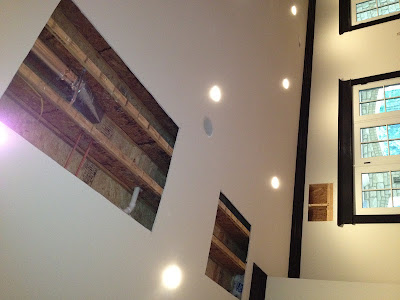If you've been a follower of this blog in the past, you'll know that our twins got off to a rocky start in life, thirteen years ago. And if you start off on a rocky road, you become better than most at navigating rocks, zigzags, and all kinds of obstacles.
They've had eleven surgeries between them: six involving life-or-death imperatives, and five involving significant quality of life decisions (one for hearing, four for vision). Quality-of-life surgeries are often difficult to choose because every surgery carries risk. And though we do not classify being able to hear and see as strictly elective, they are also not life-or-death situations. Therefore, much research and soul-searching goes into such a decision.
Recently, two separate surgeries have weighed on one daughter's mind.
When she was four years old, we made the decision for her to receive a cochlear implant in order for her to hear in one ear whose hearing had regressed to the point of being negligible. For those of you who are aware of the controversy of cochlear implants among the Deaf community, you'll know that not everyone views the cochlear implant as a positive medical intervention. (Note the big "D" in Deaf, which gives it an entirely different meaning from little-"d" deaf. I'll let you Google that on your own if you want to learn more.) But for our daughter, it was absolutely, 100%, the right decision. We know this and she knows this. Since being able to hear speech is crucial in developing the ability to produce speech, and since she was at such a young developmental age when her language should have been exponentially increasing, giving her every opportunity to hear was a no-brainer for us. She continued to use a high-powered hearing aid in the other ear, as her hearing loss was not quite as significant in that ear, allowing her to "preserve" that ear for any future treatments that would benefit her later in life.
Lately, we've seen some evidence of regression in the hearing aid ear, so we've discussed the possibility of a second cochlear implant. However, our daughter is no longer a toddler whose parents must make unilateral decisions for her. She's thirteen, and very much needs to be and wants to be involved in her own medical and lifestyle choices. Although my husband and I were completely in agreement about her first implant, we have differing opinions about a second implant. So when the subject comes up with our daughter, we're able to provide logical arguments for and against a second device. But she's the one who must make the decision. And for her, there's more than just the logical arguments.
There are also the emotional and social considerations. Surgery is risky and scary, even when you've been through it before, and SHE'S the one who must go through it. SHE'S the one who would have to cope with temporary hair loss in the surgical area, not to mention a giant bandage on her head for a few days. (That's a big deal when you're a teenager!) And a big headache for a few days. And having to miss school and make up her homework. And the adjustment to a new kind of hearing once the device is activated a month after surgery. These are real and important considerations for her, and she must weigh the potential benefits with the potential risks and side effects.
She goes back and forth. As with any major life decision, she'll know if or when the time is right. Either way, we're here to support her decision and love her.
The other surgery that's been on her mind lately - maybe even more so than the implant - is for her feet. Both girls have severe bunions. I know, it sounds like an old-lady/ugly feet issue. But in reality, young kids can develop bunions. And it's more than just a cosmetic issue; they're also painful.
We tease the girls that they've inherited the worst foot genes from both Mom and Dad. Fortunately, they're both cute as a button everywhere else.
 |
| This is NOT a foot belonging to one of my daughters! They would be mortified if I ever took a picture of their feet and posted it on online. So I found a stranger's photo online instead :) |
 | |
| As you can see from this stranger's x-ray, a bunion is more than a bump on the side of the foot. The appearance of a bump actually is caused by a deformation in the growth of the foot/toe bones. |
Both girls hate their bunions. And now that they're getting older and are attracted to cute, strappy, heeled shoes, the bunions are a cause of both cosmetic frustration and also pain for them. One of the twins doesn't really discuss her bunions too much. The other, however, has been thinking seriously of the bunion surgery that the podiatrist told them about. He was not necessarily advocating the surgery for them at this age - but as an option for the future. And he pointed out that it's very painful, with a slow recovery, so he does not recommend it for anyone except those pulling at their last straw. But she can't seem to get it off her mind these days. So I do see bunion surgery in her future. But she's in charge of that future, and she'll have to let us know when she's serious enough to go through with it.
Again, we can't make this decision for her. Our job is simply to support her decision and love her.
I'm proud of our daughters and the way they navigate their rocky road with maturity. But there are days when I do wish that their most difficult decision, at age thirteen, is what to wear today. Maybe something cute and strappy...





























